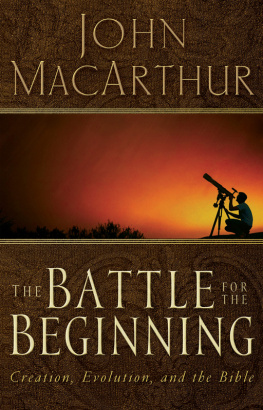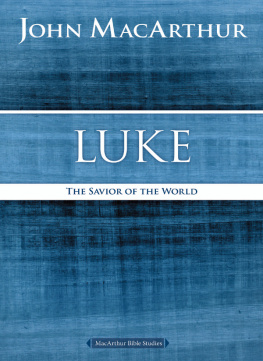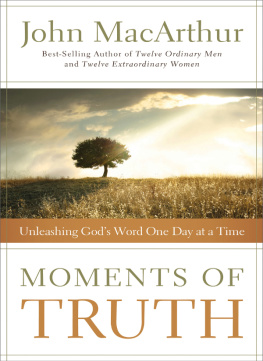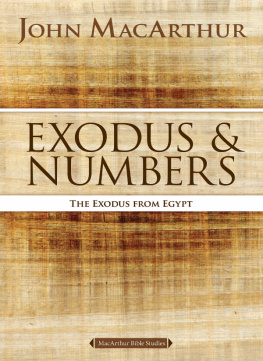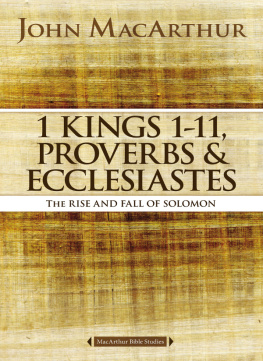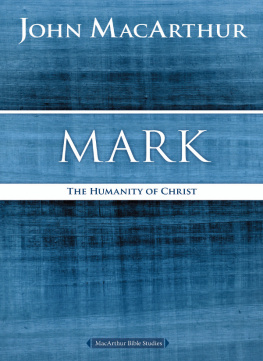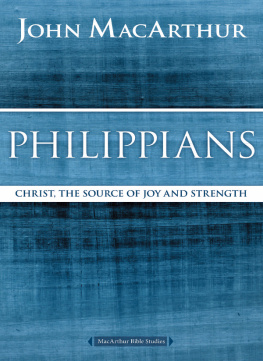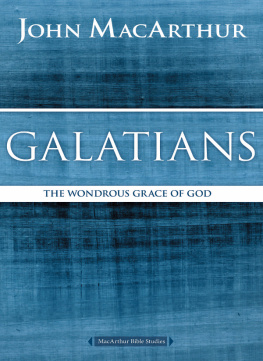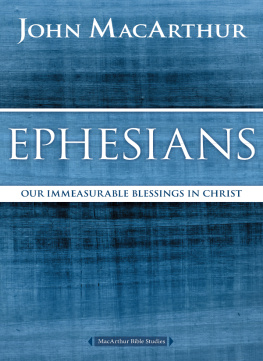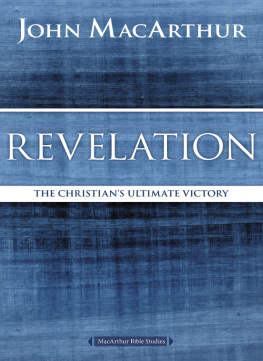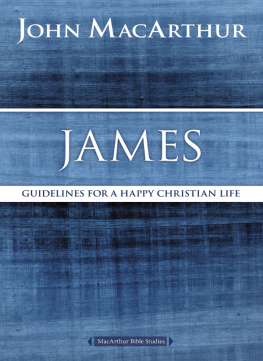ACTS
MACARTHUR BIBLE STUDIES
2007, John F. MacArthur, Jr.
All rights reserved. No portion of this book may be reproduced, stored in a retrieval system, or transmitted in any form or by any meanselectronic, mechanical, photocopy, recording, or any otherexcept for brief quotations in printed reviews, without the prior permission of the publisher.
John MacArthur
Unleashing Gods Truth, One Verse at at a Time.
Unleashing Gods Truth, One Verse at a Time is a trademark of Grace to You. All rights reserved.
Published in Nashville, Tennessee, by Nelson Books, an imprint of Thomas Nelson. Nelson Books and Thomas Nelson are registered trademarks of HarperCollins Christian Publishing, Inc.
Nelson Books titles may be purchased in bulk for education, business, fundraising, or sales promotional use. For information, please email SpecialMarkets@ThomasNelson.com
Published in association with the literary agency of Wolgemuth & Associates, Inc.
Produced with the assistance of the Livingstone Corporation. Project staff include Jake Barton, Betsy Todt Schmitt, and Andy Culbertson. Project editors: Mary Horner Collins, Amber Rae, and Len Woods
Scripture quotations marked NKJV are taken from the The New King James Version. 1982 by Thomas Nelson, Inc. Used by permission. All rights reserved.
Keys to the Text material taken from the following sources:
Anxiety Attacked. 1993, 1996 by John MacArthur, Jr. Published by Victor Books, Wheaton, Illinois. Used by permission.
The God Who Loves. 1996, 2003 by John MacArthur. Published by Thomas Nelson Publishers.
The MacArthur Study Bible (electronic ed.), John MacArthur, General Editor. 1997 by Word Publishing. All rights reserved. Used by permission.
Nelsons New Illustrated Bible Dictionary, Rev. ed. R. F. Youngblood, F. F. Bruce, R. K. Harrison, editors. 1995 by Thomas Nelson Publishers. Used by permission.
Acts. MacArthur Commentary Series. 2000 by John MacArthur. Published by Moody Press, Chicago, Illinois. Used by permission.
What Does the Bible Say About? Nelsons A to Z series. 2001 by Thomas Nelson Publishers.
Cover Art by Holly Sharp Design
Interior Design and Composition by Joel Bartlett, Livingstone Corporation
ISBN: 978-0-7180-3505-1
ISBN: 978-0-7180-3524-2 (eBook)
15 16 17 18 19 RRD 6 5 4 3 2 1
CONTENTS
As the second book Luke addressed to Theophilus (see Luke 1:3), Acts may originally have had no title. The Greek manuscripts title the book Acts, and many add of the Apostles. The Greek word translated Acts (praxeis) was often used to describe the achievements of great people. Acts does feature the notable figures in the early years of the church, especially Peter (chapters 112) and Paul (chapters 1328). But the book could more properly be called The Acts of the Holy Spirit through the Apostles, since His sovereign, superintending work was far more significant than that of any human being. The Spirit directed, controlled, and empowered the church and caused it to grow in numbers, spiritual power, and influence.
AUTHOR AND DATE
Since Lukes Gospel was the first book addressed to Theophilus (Luke 1:3), it is logical to conclude that Luke is also the author of Acts, although he is not named in either book. The writings of the early church fathers such as Irenaeus, Clement of Alexandria, Tertullian, Origen, Eusebius, and Jerome affirm Lukes authorship, and so does the Muratorian Canon (ca. AD 170). Because he is a relatively obscure figure, mentioned only three times in the New Testament (Col. 4:14; 2 Tim. 4:11; Philem. 24), it is unlikely that anyone would have forged a work to make it appear to be Lukes. A forger surely would have attributed the work to a more prominent person.
Luke was Pauls close friend, traveling companion, and personal physician (Col. 4:14). He was a careful researcher (Luke 1:14) and an accurate historian, displaying an intimate knowledge of Roman laws and customs, as well as the geography of Palestine, Asia Minor, and Italy. In writing Acts, Luke drew on written sources (15:2329; 23:2630), and he also, no doubt, interviewed key figures , such as Peter, John, and others in the Jerusalem church. Pauls two-year imprisonment at Caesarea (24:27) gave Luke ample opportunity to interview Philip and his daughters (who were considered important sources of information on the early days of the church). Finally, Lukes frequent use of the first-person plural pronouns we and us (16:1017; 20:521:18; 27:128:16) reveals that he was an eyewitness to many of the events recorded in Acts.
Some believe Luke wrote Acts after the fall of Jerusalem (AD 70; his death was probably in the mid-eighties). It is more likely, however, that he wrote much earlier, before the end of Pauls first Roman imprisonment (ca. AD 6062). That date is the most natural explanation for the abrupt ending of Acts, which leaves Paul awaiting trial before Caesar. Surely Luke, who devoted more than half of Acts to Pauls ministry, would have stated the outcome of that trial and described Pauls subsequent ministry, second imprisonment (2 Tim. 4:11), and death, if those events had happened before he wrote Acts. Lukes silence about such notable events as the martyrdom of James, head of the Jerusalem church (AD 62, according to the Jewish historian Josephus), the persecution under Nero (AD 64), and the fall of Jerusalem (AD 70) also suggests he wrote Acts before those events transpired.
BACKGROUND AND SETTING
As Luke makes clear in the prologue to his Gospel, he wrote to give Theophilus (and the others who would read his work) a narrative of those things (Luke 1:1) that Jesus had accomplished during His earthly ministry. Accordingly, Luke wrote in his Gospel an orderly account (Luke 1:3) of those momentous events. Acts continues that record, noting what Jesus accomplished through the early church. Beginning with Jesus ascension, through the birth of the church on the Day of Pentecost, to Pauls preaching at Rome, Acts chronicles the spread of the gospel (the good news of Jesus) and the growth of the church. It also records the mounting opposition to the gospel.
Theophilus, whose name means lover of God, is unknown to history apart from his mention in Luke and Acts. Whether he was a believer whom Luke was instructing or a pagan whom Luke sought to convert is not known. Lukes address of him as most excellent Theophilus (Luke 1:3) suggests that he was a Roman official of some importance (24:3; 26:25).
HISTORICAL AND THEOLOGICAL THEMES
As the first work of church history ever penned, Acts records the initial response to the Great Commission (Matt. 28:1920). It provides information on the first three decades of the churchs existencematerial found nowhere else in the New Testament. Though not primarily a doctrinal work, Acts nonetheless emphasizes that Jesus of Nazareth was Israels long-awaited Messiah, shows that the gospel is offered to all people (not merely the Jews), and stresses the work of the Holy Spirit (mentioned more than fifty times). Acts also makes frequent use of the Old Testament: for example, 2:1721 (Joel 2:2832); 2:2528 (Ps. 16:811); 2:35 (Ps. 110:1); 4:11 (Ps. 118:22); 4:2526 (Ps. 2:12); 7:4950 (Isa. 66:12); 8:3233 (Isa. 53:78); 28:2627 (Isa. 6:910).
Acts abounds with transitions: from the ministry of Jesus to that of the apostles; from the old covenant to the new covenant; from Israel as Gods witness nation to the church (composed of both Jews and Gentiles) as Gods witness people. The book of Hebrews sets forth the theology of the transition from the old covenant to the new; Acts depicts the new covenants practical outworking in the life of the church.
DRAWING NEAR
How would you rate the reputation of Christs church in the world today? Why?
THE CONTEXT
Lukes book of Acts picks up where his Gospel left off, providing details of the birth and early years of the church that Jesus had promised to build. Together, the two books, Luke and Acts, form a comprehensive and seamless account of how the followers of Jesus turned the world upside down (Acts 17:6) by taking the good news of the life, death, and resurrection of Jesus Christ to the end of the earth (Acts 1:8).
Next page

